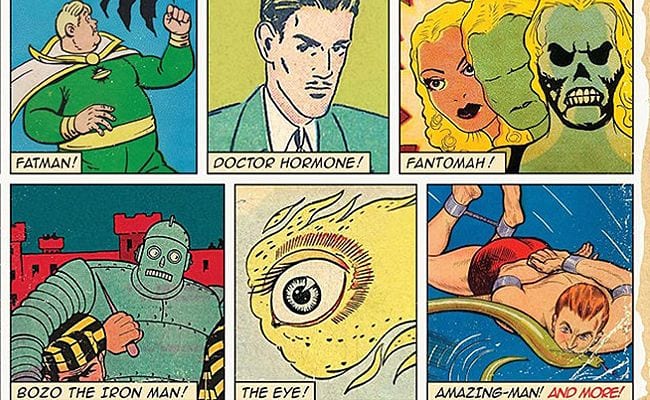
For every superhero that you can name off the top of your head—Batman, Superman, Spider-Man and Thor—there are countless others that almost no one remembers. Heroes that for one reason or another have entirely failed to stand the test of time. It’s relatively easy to champion popular culture mainstays like Captain America or The Flash. Anyone with a blog could put forth a mediocre effort and create something relatively interesting for fanboys and fangirls to read about Green Arrow, Black Widow, or Robin.
But what about the forgotten heroes whose out of print comics collect dust and gain nary a new follower? Who has the talent, the dedication to research and the much-needed sense of humor necessary to champion heroes like Captain Tootsie, Kangaroo Man or The Ferret? Author Jon Morris does in the aptly titled The League of Regrettable Superheroes.
Morris, a cartoonist and graphic designer, began writing about the stranger side of comics on his blog “Gone & Forgotten” years ago, which makes him perhaps the most suitable candidate to author such a book. The new volume published by Quirk Books compiles brief backstories about 100 of the strangest heroes to hit comics’ paneled pages since 1938. The book also contains vintage full-color artwork for each hero, from Amazing Man to Zippo, in addition to the assortment of facts and Morris’ droll commentary.
The “Regrettable” portion of the title might lead you to believe Morris’ book is filled with mockery, but it takes itself much more seriously than that. At least more serious and respectful than, say, the average person takes Aquaman. While the reasons many of the selected heroes are forgettable are often obvious, you might be expecting the entries to read more like a pop culture punching bag, filled with the worst kind of bad observational humor you might hear at an open mic night.
Instead, there’s something to be said for the surprising level of regard Morris holds for the material, no matter how strange or absurd. Nothing’s laugh-out-loud funny, but you’ll smile and learn a lot. If you pick up the title expecting continuous humor, you’ll be surprised that there are more insights than straightforward words of comedy. As Morris’ writes in the introduction, “There’s not a single character in this book who doesn’t have at least the potential to be great.”
The entries are categorized into three chronological sections: The Golden Age, The Silver Age, and the Modern Age. While comic book purists might debate the pinpoint accuracy of his timeline or even the heroes selected (since Squirrel Girl has become something of a modern favorite among Marvel readers), it’s commendable that as many heroes from the ‘40s and ‘50s are represented as heroes from the ‘80s and ‘90s. Almost every hero featured includes a description of their powers and an explanation as to why they deserve to be included in such a compilation.
The 100 selections run the gamut from otherworldly vigilantes like the truly disturbing witch Mother Hubbard to Superman knockoffs like Miracle Man and Mr. Muscles to heroes that were actually huge hits in decades past like Doll Man. Morris does sometimes make the obvious, irreverent jokes, and you can’t blame him, but he also takes time to explain how each title was more than meets the eye; even if that title happened to be about a disembodied, floating, living eye (“The Eye”).
Take, for example, Golden Age hero Red Bee, a costumed district attorney whose go-to superpower was releasing a single trained bee named Michael to assist him in dispensing justice. As Morris’ writes, “If nothing else, Red Bee deserves recognition for defying expectations. In any story, you wouldn’t normally expect a man with a belt full of bees to be the hero, right?”
Or consider Funnyman, a seltzer bottle-wielding comedic crimefighter (created by Superman creators Jerry Siegel and Joel Shuster) who debuted in 1948 and went nowhere, fast.
In fact, Morris’ takes time to remind readers that plenty of industry legends have also created their fair share of losers like Stan Lee’s snarling Ravage 2099, Joe Simon and Jack Kirby’s Vagabond Prince (who dressed he was late for marching band), and Neal Adams’ absurdly roller rink-ready Skateman. There’s a lesson there for us all; we all make mistakes.
On occasion, Morris also manages to do a more than respectable job connecting the dots between these forgotten heroes (like Bozo the Iron Man) and much more popular comic book heroes (like Marvel’s box-office icon Iron Man). For example, Morris writes that Bozo “pioneered the man-inside-the-machine motif for superheroics.”
All in all, the entries that fill the 250 pages are brief, sometimes with just three paragraphs of text, and are correspondingly lacking in depth, despite Morris’ skill for efficient, meaningful analysis. Nevertheless, when combined with the incredible artwork—beautifully reprinted covers and selected comic panels—Morris’ prose does these heroes justice. Much more justice than almost any of these characters have received in decades.
The League of Regrettable Superheroes certainly lends itself to a certain type of audience; not everyone will want to read hundreds of words about Doctor Hormone or Thunderbunny. However, comics historians, and of course, fanboys and fangirls, will love it.

